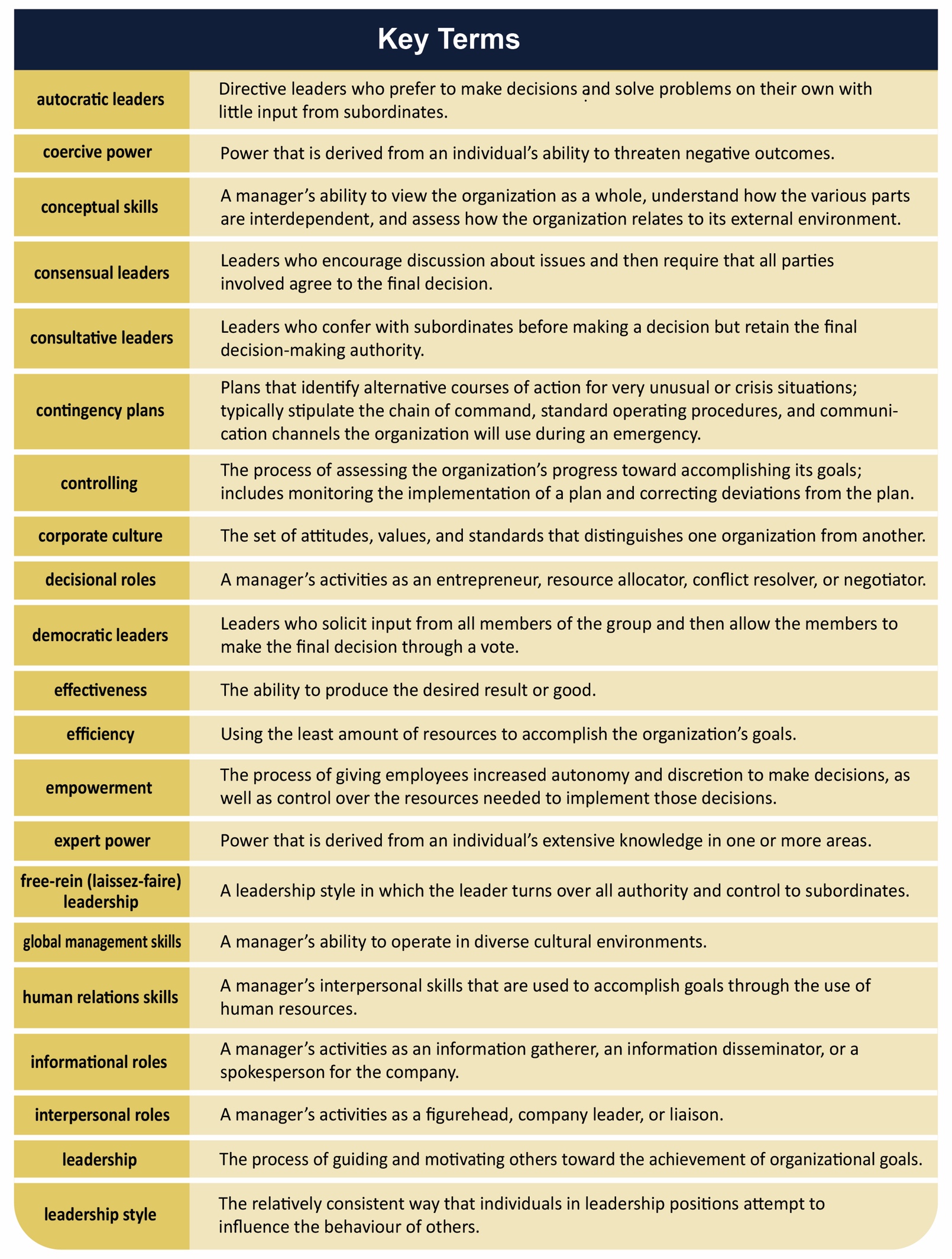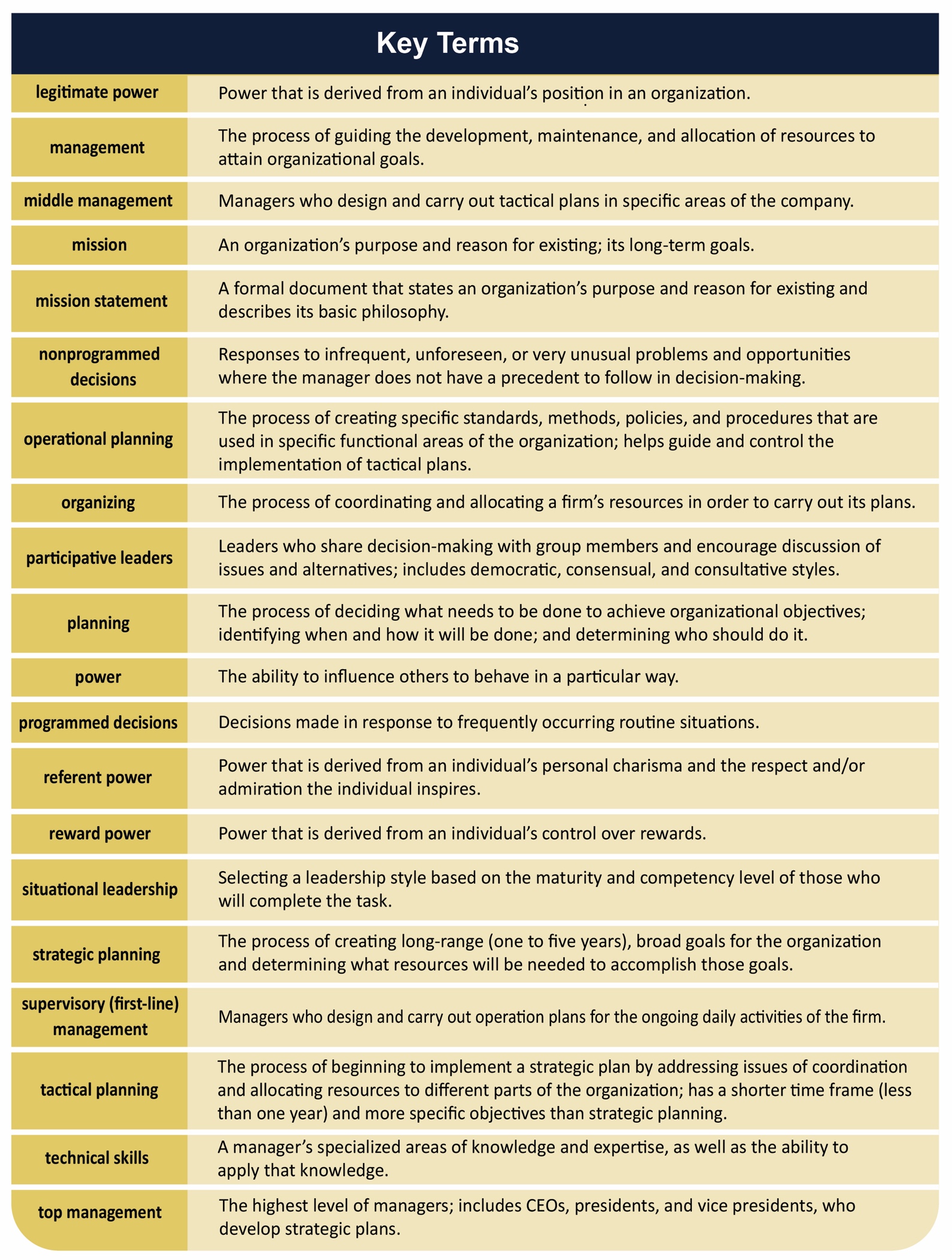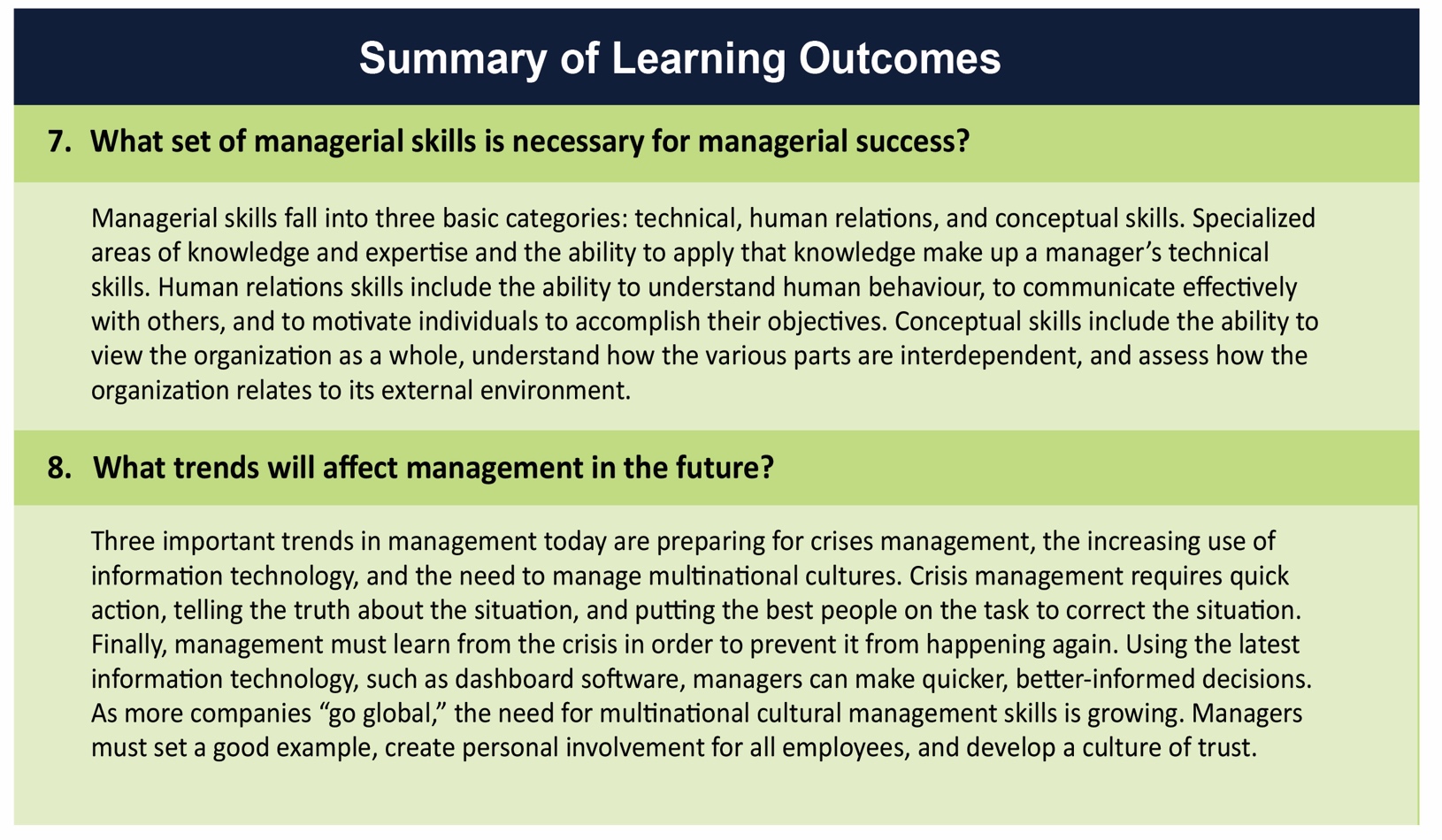Chapter 6: Management

Learning Objectives
After reading this chapter, you should be able to answer these questions:
- What is the role of management?
- What are the four types of planning?
- What are the primary functions of managers in organizing activities?
- How do leadership styles influence a corporate culture?
- How do organizations control activities?
- What roles do managers take on in different organizational settings?
- What set of managerial skills is necessary for managerial success?
- What trends will affect management in the future?
6.1 The Role of Management
What is the role of management?
Management is the process of guiding the development, maintenance, and allocation of resources to attain organizational goals. Managers are the people in the organization responsible for developing and carrying out this management process. Management is dynamic by nature and evolves to meet needs and constraints in the organization’s internal and external environments. In a global marketplace where the rate of change is rapidly increasing, flexibility and adaptability are crucial to the managerial process. This process is based in four key functional areas of the organization: planning, organizing, leading, and controlling. Although these activities are discussed separately in the chapter, they actually form a tightly integrated cycle of thoughts and actions.

From this perspective, the managerial process can be described as (1) planning – anticipating potential problems or opportunities and designing plans to deal with them, (2) organizing – coordinating and allocating the resources needed to implement plans, (3) leading – guiding personnel through the implementation process, and (4) controlling – reviewing results and making any necessary changes. This last stage provides information to be used in ongoing planning efforts, and thus the cycle starts over again. The four functions are highly interdependent, with managers often performing more than one of them at a time and each of them many times over the course of a normal workday.

The four management functions can help managers increase organizational efficiency and effectiveness. Efficiency is using the least possible amount of resources to get work done, whereas effectiveness is the ability to produce a desired result. Managers need to be both efficient and effective in order to achieve organizational goals. For example in 2016, Delta, one of the most efficient network U.S. airlines, operated at revenue of 12.15 cents per seat-mile, which is the revenue the company makes on one seat (occupied or not) the distance of one mile. No other airline came close to operating this efficiently except Southwest, which flew seats that produced 12.51 cents a mile, the best performance of all U.S. airlines.1 There are many ways that airlines can manage to produce higher revenue per seat-mile. For instance, they can raise ticket prices, fill more of their seats, operate more efficient aircrafts that utilize less fuel, or negotiate favorable salaries with their employees. While efficiency and effectiveness are sometimes lauded by investors, airlines also need to account for customer satisfaction, which can mean extra costs.2
To meet the demands of rapid growth, Skechers hired a new chief financial officer, John Vandemore, which allowed their existing CFO (David Weinberg) to concentrate on international expansion. Skechers CEO Robert Greenberg commented: “As international now represents more than 50 percent of our total business, we must continue to ramp up operations and infrastructure to meet the demand. David (Weinberg) understands how to do it the right way at the right speed to maintain our forward momentum. With John (Vandemore) handling CFO responsibilities, David will now have the bandwidth to travel and find opportunities to maximize our efficiencies around the globe.”3
As these examples show, good management uses the four management functions to increase a company’s efficiency and effectiveness, which leads to the accomplishment of organizational goals and objectives. Let’s look more closely at what each of the management functions entails.
Management 4 functions video: https://youtu.be/3OhlrAL0gQA
6.2 Planning
What are the four types of planning?
Planning begins by anticipating potential problems or opportunities the organization may encounter. Managers then design strategies to solve current problems, prevent future problems, or take advantage of opportunities. These strategies serve as the foundation for goals, objectives, policies, and procedures. Put simply, planning is deciding what needs to be done to achieve organizational objectives, identifying when and how it will be done, and determining who should do it. Effective planning requires extensive information about the external business environment in which the firm competes, as well as its internal environment.
There are four basic types of planning: strategic, tactical, operational, and contingency. Most of us use these different types of planning in our own lives. Some plans are very broad and long term (more strategic in nature), such as planning to attend graduate school after earning a bachelor’s degree. Some plans are much more specific and short term (more operational in nature), such as planning to spend a few hours in the library this weekend. Your short-term plans support your long-term plans. If you study now, you have a better chance of achieving some future goal, such as getting a job interview or attending graduate school. Like you, organizations tailor their plans to meet the requirements of future situations or events. A summary of the four types of planning appears in Table 6.2.
Strategic planning involves creating long-range (one to five years), broad goals for the organization and determining what resources will be needed to accomplish those goals. An evaluation of external environmental factors such as economic, technological, and social issues is critical to successful strategic planning. Strategic plans, such as the organization’s long-term mission, are formulated by top-level managers and put into action at lower levels in the organization.
Goals, strategies, objectives video: https://youtu.be/voZI75TyeHI

An organization’s mission is formalized in its mission statement, a document that states the purpose of the organization and its reason for existing. For example, Twitter’s mission statement formalizes both concepts while staying within its self-imposed character limit; see Table 6.3.
Mission statement video: https://youtu.be/b2MyaR0gMo0

In all organizations, plans and goals at the tactical and operational levels should clearly support the organization’s mission statement.
Tactical planning begins the implementation of strategic plans. Tactical plans have a shorter (less than one year) time frame than strategic plans and more specific objectives designed to support the broader strategic goals. Tactical plans begin to address issues of coordinating and allocating resources to different parts of the organization.
Operational planning creates specific standards, methods, policies, and procedures that are used in specific functional areas of the organization. Operational objectives are current, narrow, and resource focused. They are designed to help guide and control the implementation of tactical plans. In an industry where new versions of software have widely varying development cycles, Autodesk, maker of software tools for designers and engineers, implemented new operational plans that dramatically increased profits. Former CEO Carol Bartz shifted the company away from the erratic release schedule it had been keeping to regular, annual software releases. By releasing upgrades on a defined and predictable schedule, the company is able to use annual subscription pricing, which is more affordable for small and midsize companies. The new schedule keeps Autodesk customers on the most recent versions of popular software and has resulted in an overall increase in profitability.6
The key to effective planning is anticipating future situations and events. Yet even the best-prepared organization must sometimes cope with unforeseen circumstances, such as a natural disaster, an act of terrorism, or a radical new technology. Therefore, many companies have developed contingency plans that identify alternative courses of action for very unusual or crisis situations. The contingency plan typically stipulates the chain of command, standard operating procedures, and communication channels the organization will use during an emergency.
An effective contingency plan can make or break a company. Consider the example of Marriott Hotels in Puerto Rico. Anticipating Hurricane Maria in 2017, workers at the San Juan Marriott had to shift from their regular duties to handling the needs of not only customers, but everyone who needed assistance in the wake of the hurricane that devastated the island. A contingency plan and training for events such as this were a key part of managing this crisis.7 The company achieved its goal of being able to cater to guests and general needs due to planning and training while having a contingency plan in place. One guest commented on TripAdvisor, “Could not believe how friendly, helpful & responsive staff were even during height of hurricane. Special thanks to Eydie, Juan, Jock, Ashley and security Luis. They kept us safe & were exemplary. Will always stay at Marriott from now on.”8 Within one month after Hurricane Maria hit, operations were back to normal at the San Juan Marriott.9
6.3 Organizing
What are the primary functions of managers in organizing activities?
A second key function of managers is organizing, which is the process of coordinating and allocating a firm’s resources to carry out its plans. Organizing includes developing a structure for the people, positions, departments, and activities within the firm. Managers can arrange the structural elements of the firm to maximize the flow of information and the efficiency of work processes. They accomplish this by doing the following:
- Dividing up tasks (division of labour)
- Grouping jobs and employees (departmentalization)
- Assigning authority and responsibilities (delegation)
These and other elements of organizational structure are discussed in detail elsewhere. In this chapter, however, you should understand the three levels of a managerial hierarchy. This hierarchy is often depicted as a pyramid, as in Exhibit 6.3. The fewest managers are found at the highest level of the pyramid. Called top management, they are the small group of people at the head of the organization (such as the CEO, president, and vice president). Top-level managers develop strategic plans and address long-range issues such as which industries to compete in, how to capture market share, and what to do with profits. These managers design and approve the firm’s basic policies and represent the firm to other organizations. They also define the company’s values and ethics and thus set the tone for employee standards of behaviour. For example, Jack Welch, the former CEO of General Electric, was a role model for his managers and executives. Admirers say that he had an extraordinary capacity to inspire hundreds of thousands of people in many countries and he could change the direction of a huge organization like General Electric as if it were a small firm. Following his leadership, General Electric’s executives turned in impressive results. During his tenure, General Electric’s average annual shareholder return was 25 percent.10

The second and third tiers of the hierarchy are called middle management and supervisory (first-line) management, respectively. Middle managers (such as division heads, departmental managers, and regional sales managers) are responsible for beginning the implementation of strategic plans. They design and carry out tactical plans in specific areas of the company. They begin the process of allocating resources to meet organizational goals, and they oversee supervisory managers throughout the firm. Supervisors, the most numerous of the managers, are at the bottom of the managerial pyramid. These managers design and carry out operational plans for the ongoing daily activities of the firm. They spend a great deal of their time guiding and motivating the employees who actually produce the goods and services.
6.4 Leading, Guiding, and Motivating Others
How do leadership styles influence a corporate culture?
Leadership, the third key management function, is the process of guiding and motivating others toward the achievement of organizational goals. A leader can be anyone in an organization, regardless of position, able to influence others to act or follow, often by their own choice. Managers are designated leaders according to the organizational structure but may need to use negative consequences or coercion to achieve change. In the organization structure, top managers use leadership skills to set, share, and gain support for the company’s direction and strategy—mission, vision, and values, such as Jeff Bezos does at Amazon. Middle and supervisory management use leadership skills in the process of directing employees on a daily basis as the employees carry out the plans and work within the structure created by management. Top-level leadership demonstrated by Bezos was also exhibited by Jack Welch while leading General Electric and led to many studies of his approach to leadership. Organizations, however, need strong effective leadership at all levels in order to meet goals and remain competitive.
To be effective leaders, managers must be able to influence others’ behaviours. This ability to influence others to behave in a particular way is called power. Researchers have identified five primary sources, or bases, of power:
- Legitimate power, which comes from an individual’s position in an organization
- Reward power, which comes from an individual’s control over rewards
- Coercive power, which comes from an individual’s ability to threaten negative outcomes
- Expert power, which comes from an individual’s extensive knowledge in one or more areas
- Referent power, which comes from an individual’s personal charisma and the respect and/or admiration the individual inspires
Many leaders use a combination of all of these sources of power to influence individuals toward goal achievement. While CEO of Procter & Gamble, A.G. Lafley got his legitimate power from his position, his reward power came from reviving the company and making the stock more valuable. Also, raises and bonuses for managers who met their goals were another form of reward power. Lafley also was not hesitant to use his coercive power. He eliminated thousands of jobs, sold underperforming brands, and killed weak product lines. With nearly 40 years of service to the company, Lafley had a unique authority when it came to P&G’s products, markets, innovations, and customers. The company’s sales doubled during his nine years as CEO, and its portfolio of brands increased from 10 to 23. He captained the purchase of Clairol, Wella AG, and IAMS, as well as the multibillion-dollar merger with Gillette. As a result, Lafley had a substantial amount of referent power. Lafley is also widely respected, not only by people at P&G, but by the general business community as well. Ann Gillin Lefever, a managing director at Lehman Brothers, said, “Lafley is a leader who is liked. His directives are very simple. He sets a strategy that everybody understands, and that is more difficult than he gets credit for.”11
Leadership Styles
Individuals in leadership positions tend to be relatively consistent in the way they attempt to influence the behaviour of others, meaning that each individual has a tendency to react to people and situations in a particular way. This pattern of behaviour is referred to as leadership style. As Table 6.4 shows, leadership styles can be placed on a continuum that encompasses three distinct styles: autocratic, participative, and free rein.
Autocratic leaders are directive leaders, allowing for very little input from subordinates. These leaders prefer to make decisions and solve problems on their own and expect subordinates to implement solutions according to very specific and detailed instructions. In this leadership style, information typically flows in one direction, from manager to subordinate. The military, by necessity, is generally autocratic. When autocratic leaders treat employees with fairness and respect, they may be considered knowledgeable and decisive. But often autocrats are perceived as narrow-minded and heavy-handed in their unwillingness to share power, information, and decision-making in the organization. The trend in organizations today is away from the directive, controlling style of the autocratic leader.
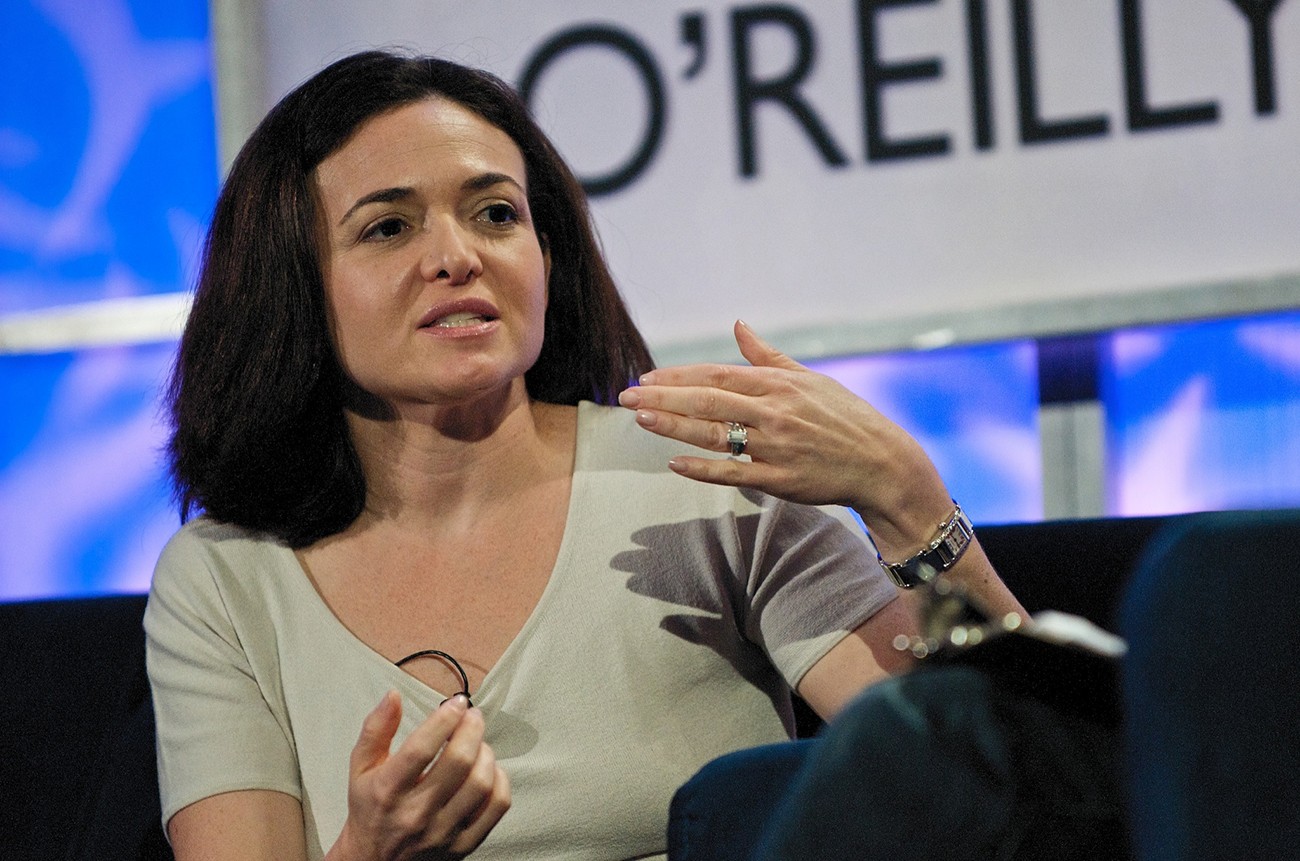
Instead, businesses are looking more and more for participative leaders, meaning leaders who share decision-making with group members and encourage discussion of issues and alternatives. Participative leaders use a democratic, consensual, consultative style. One CEO known for her participative leadership style is Meg Whitman, former CEO at Hewlett Packard. When Whitman worked at eBay, a team in the German-based operation began a promotional “treasure hunt,” launching registration pages, clues, and an hourly countdown clock. Trouble was, the launch violated eBay’s well-established corporate project-development processes.
When the treasure hunt began, 10 million contestants logged on, crashing the local servers. Rather than shut the project down, the VP in charge of the German operation allowed the promotion to be fixed and fly under the radar of corporate headquarters. Successful innovations emerged, such as an Easy Lister feature and separate registration processes for private and business sellers. When the VP shared this experience with Meg Whitman, she fostered the idea of rapid prototyping throughout the organization, which “breaks rules to get something done,” and modeled such behaviour for the entire organization.12

Participative leadership has three types: democratic, consensual, and consultative. Democratic leaders solicit input from all members of the group and then allow the group members to make the final decision through a voting process. This approach works well with highly trained professionals. The president of a physicians’ clinic might use the democratic approach. Consensual leaders encourage discussion about issues and then require that all parties involved agree to the final decision. This is the general style used by labour mediators.
Consultative leaders confer with subordinates before making a decision but retain the final decision-making authority. This technique has been used to dramatically increase the productivity of assembly-line workers.
The third leadership style, at the opposite end of the continuum from the autocratic style, is free-rein or laissez-faire (French for “leave it alone”) leadership. Managers who use this style turn over all authority and control to subordinates. Employees are assigned a task and then given free rein to figure out the best way to accomplish it. The manager doesn’t get involved unless asked. Under this approach, subordinates have unlimited freedom as long as they do not violate existing company policies. This approach is also sometimes used with highly trained professionals as in a research laboratory.
Although one might at first assume that subordinates would prefer the free-rein style, this approach can have several drawbacks. If free-rein leadership is accompanied by unclear expectations and lack of feedback from the manager, the experience can be frustrating for an employee. Employees may perceive the manager as being uninvolved and indifferent to what is happening or as unwilling or unable to provide the necessary structure, information, and expertise.
No leadership style is effective all the time. Effective leaders recognize employee growth and use situational leadership, selecting a leadership style that matches the maturity and competency levels of those completing the tasks. Newly hired employees may respond well to authoritative leadership until they understand the job requirements and show the ability to handle routine decisions. Once established, however, those same employees may start to feel undervalued and perform better under a participative or free-rein leadership style. Using situational leadership empowers employees as discussed next.
Employee Empowerment
Participative and free-rein leaders use a technique called empowerment to share decision-making authority with subordinates. Empowerment means giving employees increased autonomy and discretion to make their own decisions, as well as control over the resources needed to implement those decisions. When decision- making power is shared at all levels of the organization, employees feel a greater sense of ownership in, and responsibility for, organizational outcomes.
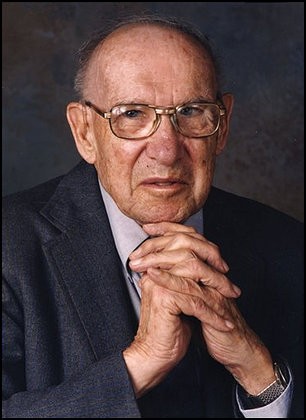
Management use of employee empowerment is on the rise. This increased level of involvement comes from the realization that people at all levels in the organization possess unique knowledge, skills, and abilities that can be of great value to the company. For example, when Hurricane Katrina hit the Gulf Coast, five miles of railroad tracks were ripped off a bridge connecting New Orleans to Slidell, Louisiana. Without the tracks, which fell into Lake Pontchartrain, Norfolk Southern Railroad couldn’t transport products between the East and West Coasts. Before the storm hit, however, Jeff McCracken, a chief engineer at the company, travelled to Birmingham with equipment he thought he might need and then to Slidell with 100 employees. After conferring with dozens of company engineers and three bridge companies, McCracken decided to try to rescue the miles of track from the lake. (Building new tracks would have taken several weeks at the least.) To do so, he gathered 365 engineers, machine operators, and other workers, who lined up eight huge cranes and, over the course of several hours, lifted the five miles of sunken tracks in one piece out of the lake and bolted it back on the bridge.13 By giving employees the autonomy to make decisions and access to required resources, Norfolk Southern was able to avoid serious interruptions in its nationwide service.
Corporate Culture
The leadership style of managers in an organization is usually indicative of the underlying philosophy, or values, of the organization. The set of attitudes, values, and standards of behaviour that distinguishes one organization from another is called corporate culture. A corporate culture evolves over time and is based on the accumulated history of the organization, including the vision of the founders. It is also influenced by the dominant leadership style within the organization. Evidence of a company’s culture is seen in its heroes (e.g., the late Andy Grove of Intel14, myths (stories about the company passed from employee to employee), symbols (e.g., the Nike swoosh), and ceremonies. The culture at Google, working in teams and fostering innovation, sometimes is overlooked while its employee perks are drooled over. But both are important to the company’s corporate culture. Since 2007 Google has been at or near the top of Fortune’s list of the “100 Best Companies to Work For,” an annual list based on employee survey results tabulated by an independent company: Great Place to Work®. 15 “We have never forgotten since our startup days that great things happen more frequently within the right culture and environment,” a company spokesperson said in response to the company first taking over the top spot.16
Culture may be intangible, but it has a tremendous impact on employee morale and a company’s success. Google approaches morale analytically. When it found that mothers were leaving the company in higher rates than other employee groups, the company improved its parental-leave policies. The result was a 50 percent reduction in attrition for working moms. An analytical approach along with culture-building activities such as town halls led by black employees and allies, support for transgender employees, and unconscious-bias workshops are why employees say Google is a safe and inclusive place to work.17 Clearly Google leaders recognize culture is critical to the company’s overall success.
6.5 Controlling
How do organizations control activities?
The fourth key function that managers perform is controlling. Controlling is the process of assessing the organization’s progress toward accomplishing its goals. It includes monitoring the implementation of a plan and correcting deviations from that plan. As Exhibit 6.6 shows, controlling can be visualized as a cyclical process made up of five stages:

Performance standards are the levels of performance the company wants to attain. These goals are based on its strategic, tactical, and operational plans. The most effective performance standards state a measurable behavioural objective that can be achieved in a specified time frame. For example, the performance objective for the sales division of a company could be stated as “$200,000 in gross sales for the month of January.” Each individual employee in that division would also have a specified performance goal. Actual firm, division, or individual performance can be measured against desired performance standards to see if a gap exists between the desired level of performance and the actual level of performance. If a performance gap does exist, the reason for it must be determined and corrective action taken.
Feedback is essential to the process of control. Most companies have a reporting system that identifies areas where performance standards are not being met. A feedback system helps managers detect problems before they get out of hand. If a problem exists, the managers take corrective action. Toyota uses a simple but effective control system on its automobile assembly lines. Each worker serves as the customer for the process and is empowered to act as a quality control inspector. If a part is defective or not installed properly, the next worker won’t accept it. Any worker can alert the supervisor to a problem by tugging on a rope that turns on a warning light (i.e., feedback). If the problem isn’t corrected, the worker can stop the entire assembly line.
Why is controlling such an important part of a manager’s job? First, it helps managers to determine the success of the other three functions: planning, organizing, and leading. Second, control systems direct employee behaviour toward achieving organizational goals. Third, control systems provide a means of coordinating employee activities and integrating resources throughout the organization.
6.6 Managerial Roles
What roles do managers take on in different organizational settings?
In carrying out the responsibilities of planning, organizing, leading, and controlling, managers take on many different roles. A role is a set of behavioural expectations, or a set of activities that a person is expected to perform.
Managerial Decision Making
In every function performed, role taken on, and set of skills applied, a manager is a decision maker. Decision- making means choosing among alternatives. Decision-making occurs in response to the identification of a problem or an opportunity. The decisions managers make fall into two basic categories: programmed and nonprogrammed. Programmed decisions are made in response to routine situations that occur frequently in a variety of settings throughout an organization. For example, the need to hire new personnel is a common situation for most organizations. Therefore, standard procedures for recruitment and selection are developed and followed in most companies.
Infrequent, unforeseen, or very unusual problems and opportunities require nonprogrammed decisions by managers. Because these situations are unique and complex, the manager rarely has a precedent to follow. The earlier example of the Norfolk Southern employee, who had to decide the best way to salvage a five-mile- long piece of railroad track from the bottom of Lake Pontchartrain, is an example of a nonprogrammed decision. Likewise, when Hurricane Katrina was forecast to make landfall, Thomas Oreck, then CEO of the vacuum manufacturer that bears his name, had to make a series of nonprogrammed decisions. Oreck’s corporate headquarters were in New Orleans, and its primary manufacturing facility was in Long Beach, Mississippi. Before the storm hit, Oreck transferred its computer systems and call-center operations to backup locations in Colorado and planned to move headquarters to Long Beach. The storm, however, brutally hit both locations. Oreck executives began searching for lost employees, tracking down generators, assembling temporary housing for workers, and making deals with UPS to begin distributing its product (UPS brought food and water to Oreck from Atlanta and took vacuums back to the company’s distribution center there). All these decisions were made in the middle of a very challenging crisis environment.
Whether a decision is programmed or nonprogrammed, managers typically follow five steps in the decision- making process, as illustrated in Exhibit 6.7:
- Recognize or define the problem or opportunity. Although it is more common to focus on problems because of their obvious negative effects, managers who do not take advantage of new opportunities may lose competitive advantage to other firms.
- Gather information to identify alternative solutions or actions.
- Select one or more alternatives after evaluating the strengths and weaknesses of each possibility.
- Put the chosen alternative into action.
- Gather information to obtain feedback on the effectiveness of the chosen plan.
It can be easy (and dangerous) for managers to get stuck at any stage of the decision-making process. For example, entrepreneurs can become paralyzed evaluating the options. For the Gabby Slome, the cofounder of natural pet food maker Ollie, the idea for starting the company came after her rescue dog began having trouble digesting store-bought pet food after living on scraps. Slome decided that the pet food industry, a $30 billion a year business, was ripe for a natural food alternative. She laments, however, that she let perfect be the enemy of the very good by indulging in “analysis paralysis.”18

6.7 Managerial Skills
What set of managerial skills is necessary for managerial success?
To be successful in planning, organizing, leading, and controlling, managers must use a wide variety of skills. A skill is the ability to do something proficiently. Managerial skills fall into three basic categories: technical, human relations, and conceptual skills. The degree to which each type of skill is used depends upon the level of the manager’s position as seen in Exhibit 6.8. Additionally, in an increasingly global marketplace, it pays for managers to develop a special set of skills to deal with global management issues.

Technical Skills
Specialized areas of knowledge and expertise and the ability to apply that knowledge make up a manager’s technical skills. Preparing a financial statement, programming a computer, designing an office building, and analyzing market research are all examples of technical skills. These types of skills are especially important for supervisory managers because they work closely with employees who are producing the goods and/or services of the firm.
Human Relations Skills
Human relations skills are the interpersonal skills managers use to accomplish goals using human resources. This set of skills includes the ability to understand human behaviour, to communicate effectively with others, and to motivate individuals to accomplish their objectives. Giving positive feedback to employees, being sensitive to their individual needs, and showing a willingness to empower subordinates are all examples of good human relations skills. Identifying and promoting managers with human relations skills are important for companies. A manager with little or no people skills can end up using an authoritarian leadership style and alienating employees.
Conceptual Skills
Conceptual skills include the ability to view the organization as a whole, understand how the various parts are interdependent, and assess how the organization relates to its external environment. These skills allow managers to evaluate situations and develop alternative courses of action. Good conceptual skills are especially necessary for managers at the top of the management pyramid, where strategic planning takes place.
6.8 Trends in Management and Leadership
What trends will affect management in the future?
Four important trends in management today are crisis management, outside directors, the growing use of information technology, and the increasing need for global management skills.
Crisis Management
Crises, both internal and external, can hit even the best-managed organization. Sometimes organizations can anticipate crises, in which case managers develop contingency plans, and sometimes they can’t. Take, for example, the sudden death of McDonald’s CEO Jim Cantalupo. The company had a solid succession plan in place and immediately named Charlie Bell as new CEO. Only a few months later, Bell announced that he had terminal cancer. Even though the company had prepared for the event of its leader’s untimely death, surely it couldn’t have anticipated that his successor would also be stricken by a terminal illness at almost the same time. Likewise, consider the devastation caused by Hurricanes Harvey, Irma, Maria, and Nate in 2017. Part of Marriott Hotels’ crisis management plan included relaxing its “no pets” policy and allowing patrons fleeing the storm to check in with their pets because it was the right thing to do.19
Crises cannot be fully anticipated, but managers can develop contingency plans to help navigate through the aftermath of a disaster. For example, consider the challenges that faced Rajiv Joseph, the author of several plays including Bengal Tiger at the Baghdad Zoo, who was in Houston preparing to open his new play, Describe the Night, at the Alley Theater when Hurricane Harvey hit and flooded the theater a few weeks prior to opening night. The six New York–based actors, the director, the stage manager, and Joseph decided to help in the relief efforts and made their way to the George Brown Convention Center, which had become the central location for relief efforts. When they arrived, and the staffers discovered they were theater artists, they were deployed to handle the writing and deployment of public address announcements and manage the incoming crowds.
What made the relief efforts successful was planning—matching the skill sets of volunteers with tasks they are best able to perform.20 Even though those in charge of the relief efforts had contingency plans, they still needed to make dozens of nonprogrammed decisions to effectively manage the ever-changing situation.21
No manager or executive can be completely prepared for these types of unexpected crises. However, how a manager handles the situation could mean the difference between disaster, survival, and even financial gain. No matter the crisis, there are some basic guidelines managers should follow to minimize negative outcomes. Managers should not become immobilized by the problem or ignore it. Managers should face the problem head on. Managers should always tell the truth about the situation and then put the best people on the job to correct the problem. Managers should ask for help if they need it, and finally, managers must learn from the experience to avoid the same problem in the future.22 Table 6.6 describes what CEOs and other leaders learned about crisis management.
Managers and Information Technology
The second trend having a major impact on managers is the proliferation of data and analytics in information technology. An increasing number of organizations are selling technology, and an increasing number are looking for cutting-edge technology to make and market the products and services they sell. One particularly useful type of technology is dashboard software. Much like the dashboard in a car, dashboard software gives managers a quick look into the relevant information they need to manage their companies. Most large companies are organized in divisions, and often each division relies on a particular type of application or database software. Dashboard software allows employees to access information from software they don’t routinely use, for example, from an application used by a different division from their own. More important, however, is the ability of a dashboard to show up-to-the-minute information and to allow employees to see all the information they need—such as financial and performance data—on a single screen.


Such integrated functionality made dashboards extremely popular. A Gartner commentary suggests that companies put data and analytics at the heart of every company business decision.23 Despite the increasing popularity of dashboard technology, the control tool has some drawbacks, such as focusing too intently on short-term results and ignoring the overall progress toward long-term goals. And some employees might bristle at being monitored as closely as dashboard tools allow.
Nonetheless, companies are seeing real results from implementing dashboard software. Robert Romanoff, a partner at the law firm of Levenfeld Romanoff in Chicago, uses dashboards that aggregate data from clients, strategic partners, and internal staff from the mailroom to the boardroom to improve what he calls the 3 Ps. The 3 Ps are process efficiency, project management, and strategic pricing.24
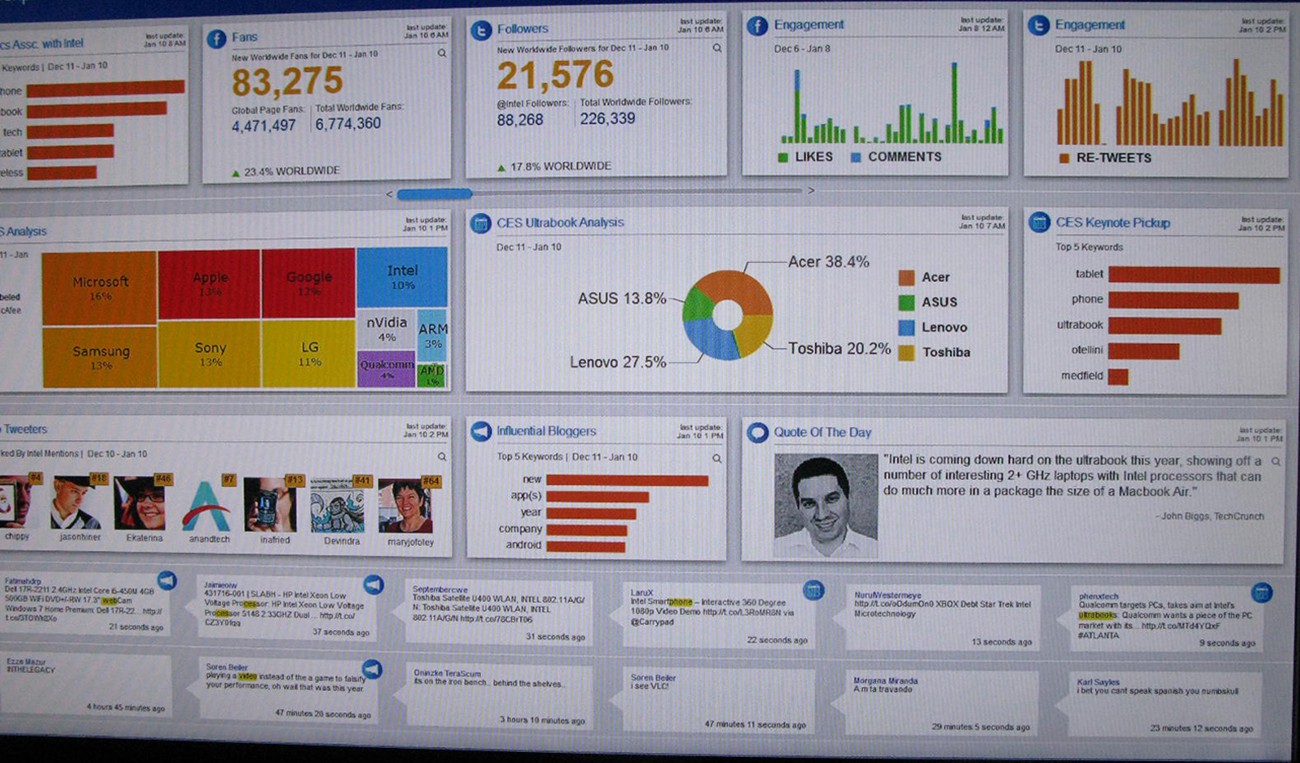
Managing Multinational Cultures
The increasing globalization of the world market has created a need for managers who have global management skills, that is, the ability to operate in diverse cultural environments. With more and more companies choosing to do business in multiple locations around the world, employees are often required to learn the geography, language, and social customs of other cultures. It is expensive to train employees for foreign assignments and pay their relocation costs; therefore, choosing the right person for the job is especially important. Individuals who are open minded, flexible, willing to try new things, and comfortable in a multicultural setting are good candidates for international management positions.

As companies expand around the globe, managers will continue to face the challenges of directing the behaviour of employees around the world. They must recognize that because of cultural differences, people respond to similar situations in very different ways. The burden, therefore, falls on the manager to produce results while adapting to the differences among the employees he or she manages.
How a manager gets results, wins respect, and leads employees varies greatly among countries, cultures, and individuals. For example, different cultures have different approaches to time. American, German, and Swiss cultures, among others, take a linear view of time, whereas southern European counties such as Italy take a multi-active time approach, and many Eastern cultures, such as China, take a cyclic approach. An American manager with a linear view of time will approach schedule planning with a different method than colleagues with a multi-active or cyclic approach.25 Despite differences such as these (examples of which can be cited for every country in the world), managing within a different culture is only an extension of what managers do every day: working with differences in employees, processes, and projects.

